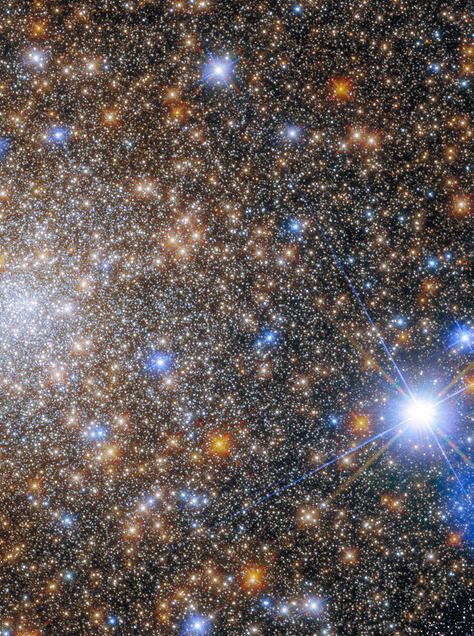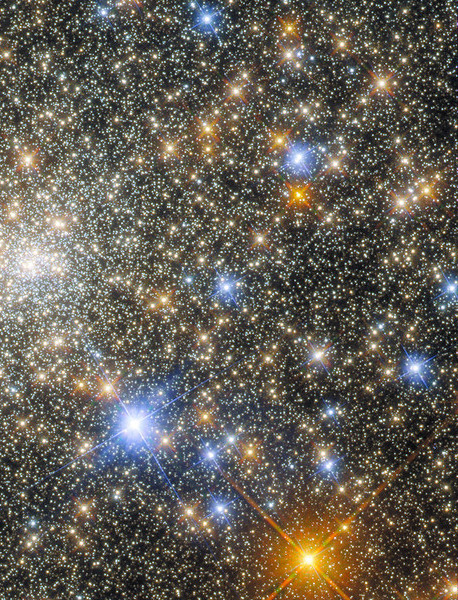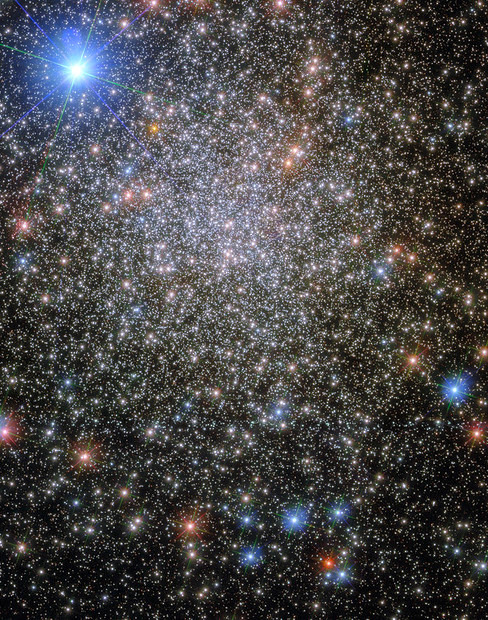Uranus- JWST NIRCam
Uranus- JWST NIRCam

This image also shows 14 of the planet’s 27 moons: Oberon, Titania, Umbriel, Juliet, Perdita, Rosalind, Puck, Belinda, Desdemona, Cressida, Ariel, Miranda, Bianca, and Portia.

This picture shows Uranus's north polar cap as well as a storm just below the polar edge.
More Posts from Ad-astra-affecte-spe and Others

NASA’s Webb, Hubble Combine to Create Most Colorful View of Universe by James Webb Space Telescope


Comet Leonard


Milky Way by Jonathon Wilcox

Voyager 2: Rings of Neptune (August 1989)

Sagittarius dwarf irregular galaxy (sagDIG) © Hubble

SPACEMAS DAY 2 ✨🪐🌎☄️☀️🌕
There's a new space telescope in the sky: Euclid. Equipped with two large panoramic cameras, Euclid captures light from the visible all the way to the near-infrared. It took five hours of observing for Euclid's 1.2-meter diameter primary mirror to capture, the 1000+ galaxies in the Perseus cluster which lies 250 million light years away. More than 100,000 galaxies are visible in the background, some as far away as 10 billion light years. Euclid's initial surveys, covering a third of the sky and recording over 2 billion galaxies, will enable a study of how dark matter and dark energy have shaped our universe.
Image Credit: ESA, NASA


Shadows of Saturn

The original Voyager 1 "Blue Movie" which records its approach during a period of over 60 Jupiter days (January 6 - February 3, 1979)
-
 spaghetti-chronicles liked this · 4 months ago
spaghetti-chronicles liked this · 4 months ago -
 silvermags reblogged this · 8 months ago
silvermags reblogged this · 8 months ago -
 runfrommeplz liked this · 8 months ago
runfrommeplz liked this · 8 months ago -
 boop-your-dragons reblogged this · 9 months ago
boop-your-dragons reblogged this · 9 months ago -
 boop-your-dragons liked this · 9 months ago
boop-your-dragons liked this · 9 months ago -
 goomy-where-they-shouldnt-be reblogged this · 9 months ago
goomy-where-they-shouldnt-be reblogged this · 9 months ago -
 thenebulousthey reblogged this · 11 months ago
thenebulousthey reblogged this · 11 months ago -
 country-n-proud liked this · 11 months ago
country-n-proud liked this · 11 months ago -
 spookycollectorenthusiast reblogged this · 11 months ago
spookycollectorenthusiast reblogged this · 11 months ago -
 spookycollectorenthusiast liked this · 11 months ago
spookycollectorenthusiast liked this · 11 months ago -
 saltytacomiracle liked this · 1 year ago
saltytacomiracle liked this · 1 year ago -
 jenikoko liked this · 1 year ago
jenikoko liked this · 1 year ago -
 ssenthgill reblogged this · 1 year ago
ssenthgill reblogged this · 1 year ago -
 ssenthgill liked this · 1 year ago
ssenthgill liked this · 1 year ago -
 kadondon liked this · 1 year ago
kadondon liked this · 1 year ago -
 annasdelusionalblog liked this · 1 year ago
annasdelusionalblog liked this · 1 year ago -
 aphoticstorm liked this · 1 year ago
aphoticstorm liked this · 1 year ago -
 bart-88 liked this · 1 year ago
bart-88 liked this · 1 year ago -
 pessimisticnathy liked this · 1 year ago
pessimisticnathy liked this · 1 year ago -
 bookmark-artisan reblogged this · 1 year ago
bookmark-artisan reblogged this · 1 year ago -
 a-world-ender liked this · 1 year ago
a-world-ender liked this · 1 year ago -
 pivoinemauve liked this · 1 year ago
pivoinemauve liked this · 1 year ago -
 chazza-studies-mphys liked this · 1 year ago
chazza-studies-mphys liked this · 1 year ago -
 remo7e reblogged this · 1 year ago
remo7e reblogged this · 1 year ago -
 andy-61699 liked this · 1 year ago
andy-61699 liked this · 1 year ago -
 tzarevna-nesmeyana reblogged this · 1 year ago
tzarevna-nesmeyana reblogged this · 1 year ago -
 tzarevna-nesmeyana liked this · 1 year ago
tzarevna-nesmeyana liked this · 1 year ago -
 starlit-goose liked this · 1 year ago
starlit-goose liked this · 1 year ago -
 hoodoo-haven reblogged this · 1 year ago
hoodoo-haven reblogged this · 1 year ago -
 voirrse liked this · 1 year ago
voirrse liked this · 1 year ago -
 fef65b-felix liked this · 1 year ago
fef65b-felix liked this · 1 year ago -
 trashpaintedgold reblogged this · 1 year ago
trashpaintedgold reblogged this · 1 year ago -
 celadondaze reblogged this · 1 year ago
celadondaze reblogged this · 1 year ago -
 celadondaze liked this · 1 year ago
celadondaze liked this · 1 year ago -
 studyingfairytale reblogged this · 1 year ago
studyingfairytale reblogged this · 1 year ago -
 luarenah liked this · 1 year ago
luarenah liked this · 1 year ago -
 ghraey reblogged this · 1 year ago
ghraey reblogged this · 1 year ago -
 yippee-ki-yoyo reblogged this · 1 year ago
yippee-ki-yoyo reblogged this · 1 year ago -
 main-midas reblogged this · 1 year ago
main-midas reblogged this · 1 year ago -
 main-midas liked this · 1 year ago
main-midas liked this · 1 year ago -
 slushsie liked this · 1 year ago
slushsie liked this · 1 year ago -
 huntressofartemis001 liked this · 1 year ago
huntressofartemis001 liked this · 1 year ago -
 sadchtulhu reblogged this · 1 year ago
sadchtulhu reblogged this · 1 year ago -
 sadchtulhu liked this · 1 year ago
sadchtulhu liked this · 1 year ago

★•Astronomy, Physics, and Aerospace•★ Original and Reblogged Content curated by a NASA Solar System Ambassador
204 posts










